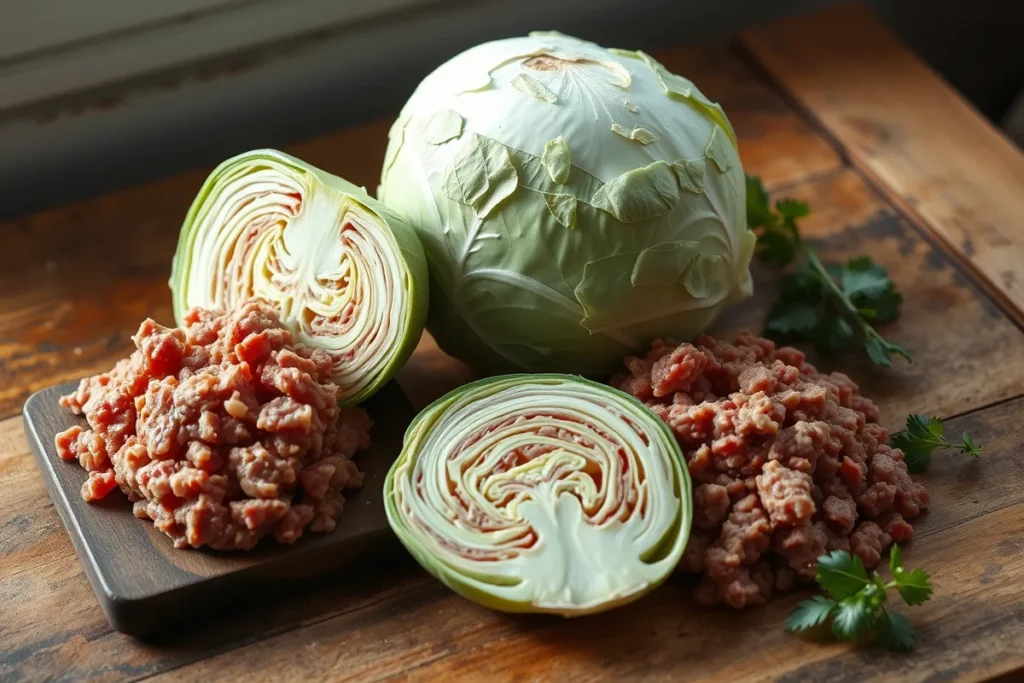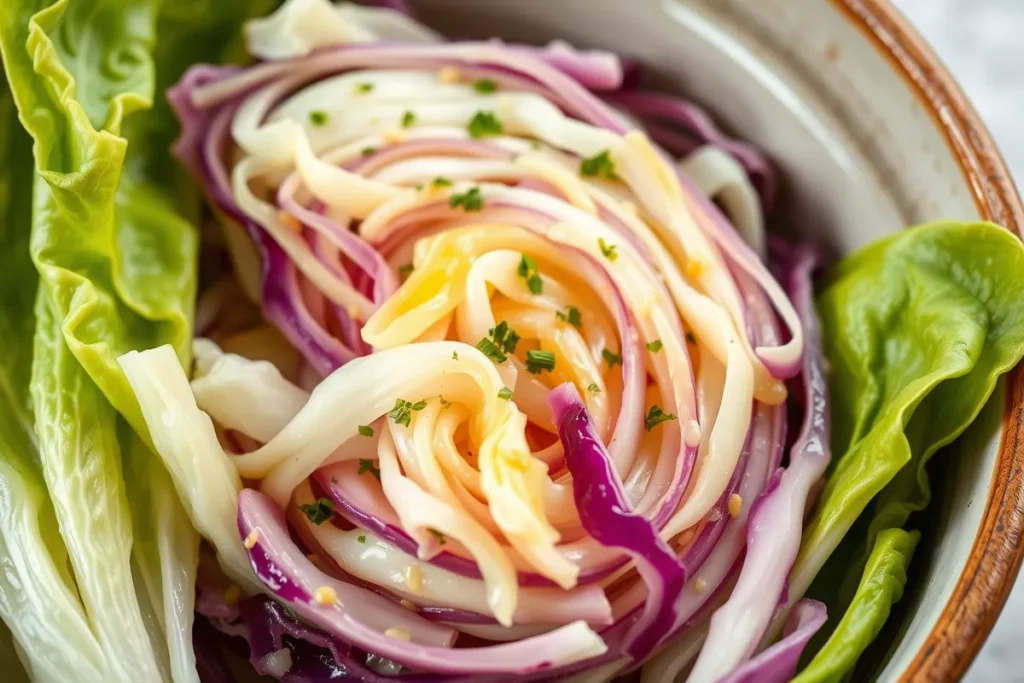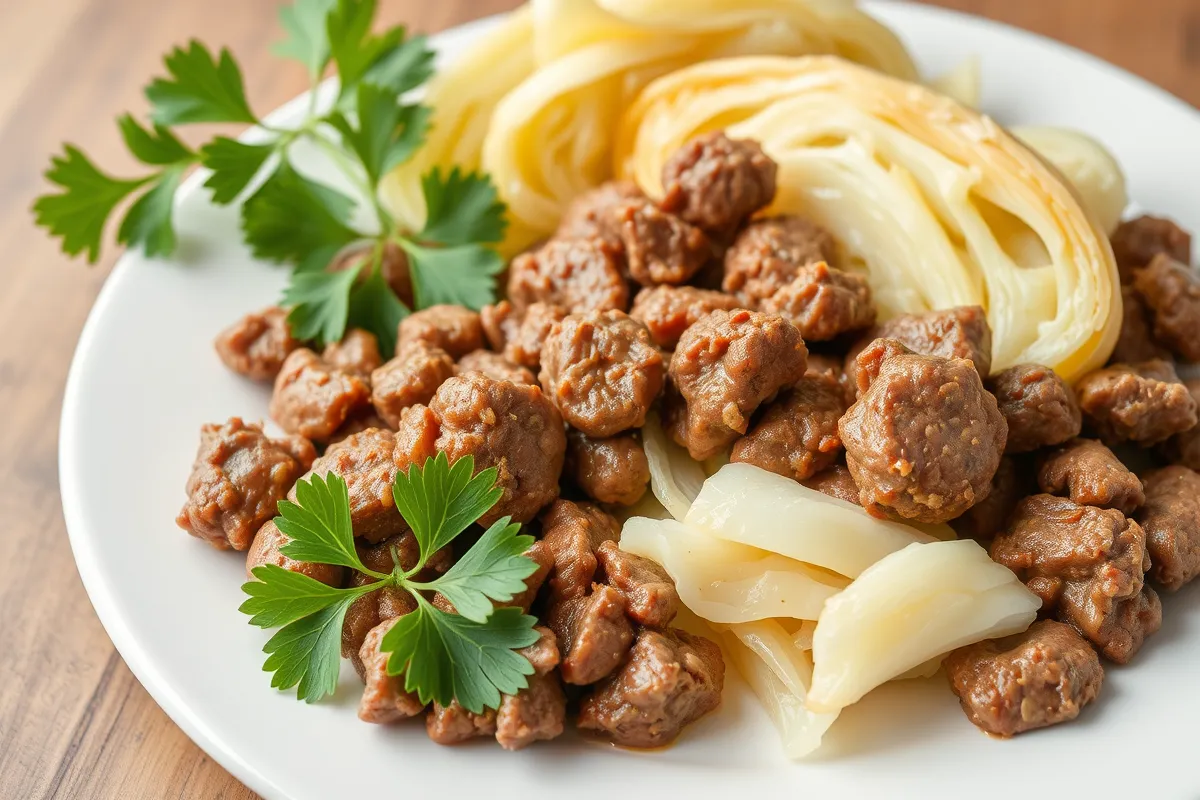Discovering the caloric content of the foods we enjoy daily can significantly impact how we approach our health and dietary goals. Combining cabbage and ground beef in recipes is common, as they’re versatile, flavorful, and nutritious. But exactly how many calories are in cabbage and ground beef? This article provides a comprehensive breakdown of the calorie counts in raw and cooked forms, their nutritional profiles, and tips for creating healthier dishes without sacrificing flavor. Let’s dig into the details, starting with the fundamentals.
Understanding Caloric Content in Foods

Importance of Knowing Calorie Counts
It’s no secret that calorie awareness is crucial for maintaining a balanced diet. Understanding how many calories you’re consuming can help with weight management, meal planning, and meeting your nutritional needs. For instance, knowing the calories in cabbage and ground beef helps make informed choices while cooking family meals or exploring new recipes.
Calories provide the body with energy, but excess consumption can lead to unwanted weight gain. On the flip side, insufficient calorie intake may leave you feeling lethargic or even compromise your health.
Overview of Cabbage and Ground Beef in Diets
Cabbage and ground beef aren’t just tasty—they’re packed with nutrients. Cabbage is often celebrated for being low in calories yet high in fiber and vitamins, while ground beef offers a significant protein punch. Together, they make a hearty duo, whether in stir-fries, soups, or casseroles.
Despite their benefits, the calorie count can vary depending on preparation methods. Raw cabbage, for example, is a low-calorie champion, but cooking with oils or mixing with fatty ground beef can increase the total caloric value. By understanding their caloric content, you can adapt your meals to suit your health goals without skimping on deliciousness.
Nutritional Profile of Cabbage
Calories in Raw Cabbage

Cabbage is a nutritional powerhouse, and one of its best features is its incredibly low calorie count. In its raw form, this leafy vegetable contains just 25 calories per 100 grams. That’s about a handful of shredded cabbage! If you’re looking for a way to add volume to your meals without significantly increasing the calorie content, cabbage is your go-to choice.
Interestingly, the calorie count is fairly consistent across varieties like green, red, and savoy cabbage. Red cabbage, for example, has just a touch more natural sugars but remains similarly low in calories, making it ideal for fresh salads or slaws.
Calories in Cooked Cabbage
Cooking cabbage changes its nutritional profile slightly, depending on the preparation method. Steamed or boiled cabbage retains its low-calorie nature, with only about 20-30 calories per cup, because cooking reduces its water content without adding significant calories.
However, sautéed cabbage is a different story. Adding oil or butter increases the calorie count, with every tablespoon of oil contributing an additional 120 calories. For calorie-conscious cooking, try steaming cabbage and seasoning it with herbs, spices, or a splash of lemon juice to keep the calorie count in check.
Health Benefits of Cabbage
Cabbage isn’t just about being low in calories—it’s packed with nutrients that contribute to overall health:
- Rich in Vitamins: Cabbage provides a generous dose of vitamin C, a key antioxidant that boosts the immune system and promotes healthy skin. It’s also high in vitamin K, which is crucial for blood clotting and bone health.
- High in Fiber: With its high fiber content, cabbage supports digestive health, keeps you feeling full longer, and may even help regulate blood sugar levels.
- Low in Fat and Sodium: Cabbage is naturally fat-free and low in sodium, making it an excellent choice for heart-healthy diets.
Adding cabbage to your meals is an easy way to enhance their nutritional value while keeping calories in check. Whether raw or cooked, it’s a versatile ingredient that fits seamlessly into a wide range of dishes.
Nutritional Profile of Ground Beef
Understanding Ground Beef Fat Percentages
When it comes to ground beef, fat content plays a significant role in determining its caloric value. Ground beef is typically labeled with lean-to-fat ratios, such as 80/20 or 90/10. These ratios indicate the percentage of lean meat versus fat:
- 80/20 Ground Beef: Contains 80% lean meat and 20% fat, delivering a richer flavor but higher calories.
- 90/10 Ground Beef: Contains 90% lean meat and 10% fat, making it a leaner choice with fewer calories.
The higher the fat content, the greater the number of calories. This makes it important to select the ratio that best aligns with your health goals or recipes.
Calories in Raw Ground Beef
The calorie count for raw ground beef varies depending on the fat percentage:
- 80/20 Ground Beef: Approximately 290 calories per 100 grams.
- 90/10 Ground Beef: Approximately 215 calories per 100 grams.
Lean ground beef is an excellent choice for reducing calorie intake while maintaining high protein levels. However, keep in mind that cooking reduces the fat content slightly, altering the final calorie count.
Calories in Cooked Ground Beef
Cooking ground beef results in fat rendering, which reduces the calorie count in the finished product. For instance:
- 80/20 Cooked Ground Beef: Approximately 230 calories per 100 grams.
- 90/10 Cooked Ground Beef: Approximately 170 calories per 100 grams.
If you’re aiming to lower the calorie count even further, draining the fat after cooking or rinsing the meat with warm water can help reduce the residual fat content.
Health Considerations
Ground beef is a nutritional staple for its protein content, but it’s essential to balance its consumption with other health factors:
- Saturated Fat: Higher-fat ground beef contains more saturated fat, which can contribute to elevated cholesterol levels if consumed excessively. Choosing leaner options can reduce this risk.
- Protein Powerhouse: Ground beef is rich in high-quality protein, supporting muscle maintenance, repair, and overall health.
- Iron and B Vitamins: It’s also a great source of iron, which prevents anemia, and B vitamins, which boost energy and support brain function.
By understanding the calorie count and nutritional impact of ground beef, you can make informed choices that complement your health and fitness goals.
Combined Caloric Content in Dishes
Popular Dishes Featuring Cabbage and Ground Beef

When you combine cabbage and ground beef, you get a delightful balance of flavors, textures, and nutrients. These two ingredients are the stars of many hearty dishes. However, their combined caloric content varies based on preparation methods and additional ingredients. Let’s break down some classic recipes.
Stuffed Cabbage Rolls
Stuffed cabbage rolls are a traditional comfort food that’s as delicious as it is filling. The rolls are typically made by wrapping seasoned ground beef and rice in cabbage leaves, then simmering them in a tangy tomato sauce.
- Calorie Count:
One stuffed cabbage roll (about 150g) contains approximately 150-200 calories. The calorie range depends on the fat content of the ground beef and the amount of rice used. - Tips to Reduce Calories:
- Use lean ground beef (90/10 ratio) to lower the fat content.
- Replace white rice with cauliflower rice for fewer carbs and calories.
Cabbage and Ground Beef Stir-Fry
This dish is a quick, one-pan meal perfect for busy weeknights. Ground beef is browned and mixed with shredded cabbage, garlic, soy sauce, and a touch of sesame oil.
- Calorie Count:
A typical serving of cabbage and ground beef stir-fry (about 1 cup) has 250-300 calories. Adding oils or sweet sauces can increase the calorie count. - Tips to Reduce Calories:
- Limit the use of added oils; opt for nonstick pans or cooking sprays.
- Add vegetables like carrots or bell peppers for bulk without extra calories.
Cabbage and Beef Soup
Cabbage and beef soup is a warming, nutrient-packed dish perfect for colder months. The broth-based soup typically includes cabbage, ground beef, tomatoes, onions, and a medley of spices.
- Calorie Count:
One serving (about 2 cups) of cabbage and beef soup contains approximately 150-200 calories. The low-calorie count makes it an excellent option for lighter meals. - Tips to Reduce Calories:
- Use a leaner ground beef variety.
- Skip cream or cheese-based toppings to keep the soup light.
Why These Dishes Stand Out
These recipes combine the fiber-rich benefits of cabbage with the protein-packed punch of ground beef. Whether you’re preparing stuffed rolls, stir-fry, or soup, the combination offers a satiating, nutrient-dense meal. Plus, you can easily modify the recipes to suit specific dietary needs, making them perfect for calorie-conscious cooks.
Factors Influencing Caloric Content
Cooking Methods and Their Impact
The way you prepare cabbage and ground beef can significantly affect their caloric content. Cooking methods can either enhance the flavors while keeping calories in check or add unnecessary fats and sugars. Let’s explore how different techniques influence the total calories in your dishes.
Boiling and Steaming
These are some of the healthiest ways to prepare cabbage. Boiling or steaming preserves the vegetable’s natural low-calorie nature while softening its texture.
- Cabbage: Boiled or steamed cabbage retains its low calorie count of 20-30 calories per cup.
- Ground Beef: Boiling ground beef isn’t common, but steaming or boiling it after cooking can help reduce the fat content by draining off excess grease.
Sautéing and Frying
Sautéing cabbage and ground beef can add flavor but also increases the calorie count. The use of oils, butter, or even sugar for caramelization contributes to the total calorie load.
- Adding just one tablespoon of oil to your stir-fry introduces an additional 120 calories.
- Frying ground beef can retain more fat than draining it post-cooking, leading to a higher calorie count.
To reduce calories, opt for low-fat cooking sprays or nonstick pans. Using broth instead of oil for sautéing cabbage is another calorie-friendly hack.
Baking and Roasting
Baking and roasting are versatile methods that enhance the natural flavors of cabbage and ground beef. When baking dishes like stuffed cabbage rolls or casseroles, the calorie count largely depends on added ingredients such as cheese, sauces, or breadcrumbs.
- One stuffed cabbage roll baked with minimal oil or sauce contains 150-200 calories.
- Roasted cabbage with just a light drizzle of olive oil has about 50 calories per serving.
Portion Sizes
Even the healthiest meals can exceed calorie limits if portion sizes aren’t controlled. Many people unintentionally overestimate serving sizes, leading to higher calorie consumption.
Importance of Accurate Measurements
Using a kitchen scale or measuring cups ensures you’re eating appropriate portions. For example:
- A proper serving of cooked cabbage is 1 cup, roughly 80-90 grams.
- Ground beef servings should be limited to about 3-4 ounces (85-113 grams) to manage calorie intake.
Visual Estimations and Pitfalls
If you don’t have measuring tools handy, use visual cues:
- A cup of cabbage is about the size of a clenched fist.
- A 3-ounce portion of ground beef is roughly the size of a deck of cards.
While estimating can be helpful, it’s often inaccurate. Regularly weighing or measuring portions can help you stay mindful of your calorie goals.
FAQs on Caloric Content of Cabbage and Ground Beef
How many calories are in a cup of cooked cabbage?
A cup of cooked cabbage contains approximately 20-30 calories, depending on the cooking method. Boiling or steaming cabbage adds no extra calories, making it one of the best ways to retain its low-calorie profile.
Does draining fat from cooked ground beef reduce calorie content?
Yes, draining fat from cooked ground beef can significantly lower its calorie content. For instance, draining and rinsing 80/20 ground beef can reduce its calorie count from about 290 calories per 100 grams to around 230 calories.
Are there significant calorie differences between green and red cabbage?
Not really! Both green and red cabbage are low in calories, with only a slight variation due to the natural sugars in red cabbage. On average, green cabbage has about 25 calories per 100 grams, while red cabbage has around 30 calories.
How does the fat percentage in ground beef affect its calorie content?
The fat percentage in ground beef directly impacts its calorie count:
- 80/20 Ground Beef: Roughly 290 calories per 100 grams.
- 90/10 Ground Beef: About 215 calories per 100 grams.
Choosing leaner ground beef helps reduce both calories and saturated fat intake.
What is the calorie count of a typical cabbage and ground beef casserole?
A serving of cabbage and ground beef casserole, depending on ingredients and preparation, typically ranges from 150-300 calories. Using lean ground beef, minimal oils, and reduced-fat cheese can lower the total calorie content.
How can I reduce the calorie content when cooking with ground beef and cabbage?
Here are a few tips to cut down on calories:
- Use lean ground beef (90/10 or leaner).
- Opt for cooking methods like steaming or boiling rather than frying.
- Replace calorie-dense ingredients (e.g., rice or heavy creams) with lighter options like cauliflower rice or unsweetened tomato sauce.
By making these small adjustments, you can enjoy flavorful dishes without compromising your calorie goals.
Summarizing Caloric Insights
Making Informed Dietary Choices
Cabbage and ground beef are a dynamic duo in the kitchen, offering a versatile base for countless dishes. While cabbage is incredibly low in calories and packed with essential nutrients like fiber and vitamins, ground beef brings protein and flavor to the table. However, balancing the calorie content of ground beef (which varies significantly with its fat percentage) is key to keeping meals healthy and satisfying.
Understanding the calories in cabbage and ground beef allows you to tailor recipes to your health goals. By choosing leaner cuts of ground beef, sticking to portion guidelines, and using calorie-friendly cooking methods like steaming and boiling, you can enjoy hearty meals without overloading on calories.

Conclusion
Ultimately, how many calories are in cabbage and ground beef depends on how you prepare and portion them. A dish like cabbage and ground beef soup, for instance, can be a filling, low-calorie meal with about 150 calories per serving, while sautéed cabbage and beef stir-fry might contain 250-300 calories per cup. The beauty of these ingredients lies in their adaptability—you can tweak recipes to suit your taste buds and dietary needs.
By pairing the nutrient density of cabbage with the protein power of ground beef, you can craft meals that are not only delicious but also mindful of your calorie intake. Whether you’re cooking for health, taste, or both, this combination remains a winning choice for any kitchen.
Explore these ideas further by experimenting with your favorite cabbage and ground beef recipes, and remember: mindful preparation is the secret to striking the perfect balance between flavor and nutrition.

